Johan
Off-grid energy systems enthusiast.
Price: $2100
The price is for one battery. I have four in total.
Reason for sale: Intended for training, but that was canceled, so they have never been used.
Warranty: These batteries have a limited factory warranty of 3 years, starting on 2023/08/21 and ending on 2026/08/21.
Shipping: USPS Ground from Sacramento 95818 (for example, to Los Angeles, CA 90210 would be roughly $80)
NO BMS included. External Victron BMS is required.
These batteries have the highest energy density (both in weight and volume) for the LFP chemistry on the market. Just compare with brands like EG4 or Battleborn. Also LFP is much safer compared to the slightly lighter Cobalt-based chemistries involving child labor for Cobalt mining.
Why lithium-iron-phosphate? Because it is rugged. A lead-acid battery will fail prematurely due to sulfation:
• If it operates in deficit mode during long periods of time (i.e. if the battery is rarely, or never at all, fully charged).
• If it is left partially charged or worse, fully discharged (boat or RV during winter).
An LFP battery
• Does not need to be fully charged. Service life even slightly improves in case of partial charge instead of a full charge. This is a major advantage of LFP compared to lead-acid.
• Other advantages are the wide operating temperature range, excellent cycling performance, low internal resistance and high efficiency (see below). LFP is therefore the chemistry of choice for demanding applications.
Efficient
• In several applications (especially off-grid solar and/or wind), energy efficiency can be of crucial importance.
• The round-trip energy efficiency (discharge from 100 % to 0 % and back to 100 % charged) of the average lead-acid battery is 80 %.
• The round-trip energy efficiency of a LFP battery is 92 %.
• The charge process of lead-acid batteries becomes particularly inefficient when the 80 % state of charge has been reached, resulting in efficiencies of 50 % or even less in solar systems where several days of reserve energy is required (battery operating in 70 % to 100 % charged state).
• In contrast, a LFP battery will still achieve 90 % efficiency under shallow discharge conditions.
Size and weight
• Saves up to 70 % in space
• Saves up to 70 % in weight
Expensive?
• LFP batteries are expensive when compared to lead-acid. But in demanding applications, the high initial cost will be more than compensated by longer service life, superior reliability and excellent efficiency.
Bluetooth
• With Bluetooth cell voltages, temperature and alarm status can be monitored.
• Instant readout: The VictronConnect App can display the most important data on the Device list page without the need to connect to the product.
• Very useful to localize a (potential) problem, such as cell imbalance.
SPECIFICATIONS
GENERAL
• Cell chemistry: Lithium Iron Phosphate / LiFePO4 / LFP
• Number of cells: 4
• Can be connected in series, parallel and series/parallel: Yes, 12V, 24V or 48V.
• Maximum number of batteries in one system: 20.
• NO BMS included. External Victron BMS is required.
• Nominal voltage: 12.8V
• Nominal capacity at 25degC (Discharge current ≤1C) : 330Ah or 4.224kWh
• Production date: week 40 of 2022
DISCHARGE
• Max continuous discharge current: 400A
• Recommended continuous discharge current: 300A
• End of discharge voltage: 11.2V (2.80Vpc)
• Internal resistance: 0.8mΩ
CHARGE
• Charge voltage: Between 14.0 V (3.50Vpc) and 14.4 V (3.60Vpc), while recommended 14.2 V (3.55Vpc)
• Float voltage: 13.5 V (3.375Vpc)
• Maximum charge current: 400 A
• Recommended charge current: ≤150 A
OPERATING CONDITIONS
• Operating temperature:
• Discharge Operating temperature: -20°C to +50°C;
• Charge Operating temperature: +5°C to +50°C
• Storage temperature: -45°C to +70°C
• Humidity (non-condensing): Max. 95 %
• Protection class: IP 22
CYCLE LIFE (capacity ≥ 80% of nominal)
• Cycle life 80 / 70 / 50% DoD: 2500 / 3000 / 5000 cycles
OTHER
• Max storage time @ 25°C when fully charged: 1 year
• BMS connection: Male + female cable with M8 circular connector, length 500mm
• Power connection (threaded inserts): M10
• Dimensions (h x w x d): 265 x 359 x 206mm
• Weight: 29 kg
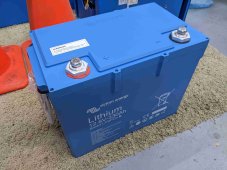
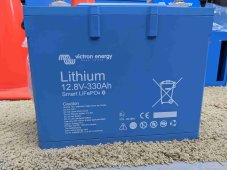
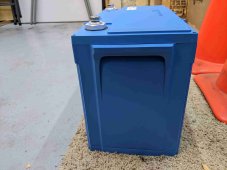

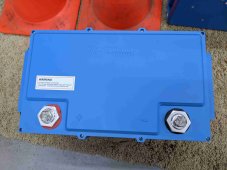
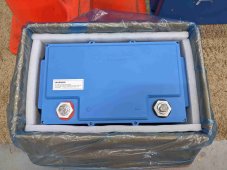
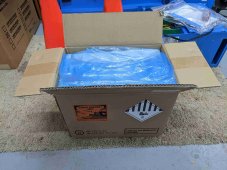
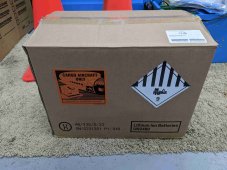
The price is for one battery. I have four in total.
Reason for sale: Intended for training, but that was canceled, so they have never been used.
Warranty: These batteries have a limited factory warranty of 3 years, starting on 2023/08/21 and ending on 2026/08/21.
Shipping: USPS Ground from Sacramento 95818 (for example, to Los Angeles, CA 90210 would be roughly $80)
NO BMS included. External Victron BMS is required.
These batteries have the highest energy density (both in weight and volume) for the LFP chemistry on the market. Just compare with brands like EG4 or Battleborn. Also LFP is much safer compared to the slightly lighter Cobalt-based chemistries involving child labor for Cobalt mining.
Why lithium-iron-phosphate? Because it is rugged. A lead-acid battery will fail prematurely due to sulfation:
• If it operates in deficit mode during long periods of time (i.e. if the battery is rarely, or never at all, fully charged).
• If it is left partially charged or worse, fully discharged (boat or RV during winter).
An LFP battery
• Does not need to be fully charged. Service life even slightly improves in case of partial charge instead of a full charge. This is a major advantage of LFP compared to lead-acid.
• Other advantages are the wide operating temperature range, excellent cycling performance, low internal resistance and high efficiency (see below). LFP is therefore the chemistry of choice for demanding applications.
Efficient
• In several applications (especially off-grid solar and/or wind), energy efficiency can be of crucial importance.
• The round-trip energy efficiency (discharge from 100 % to 0 % and back to 100 % charged) of the average lead-acid battery is 80 %.
• The round-trip energy efficiency of a LFP battery is 92 %.
• The charge process of lead-acid batteries becomes particularly inefficient when the 80 % state of charge has been reached, resulting in efficiencies of 50 % or even less in solar systems where several days of reserve energy is required (battery operating in 70 % to 100 % charged state).
• In contrast, a LFP battery will still achieve 90 % efficiency under shallow discharge conditions.
Size and weight
• Saves up to 70 % in space
• Saves up to 70 % in weight
Expensive?
• LFP batteries are expensive when compared to lead-acid. But in demanding applications, the high initial cost will be more than compensated by longer service life, superior reliability and excellent efficiency.
Bluetooth
• With Bluetooth cell voltages, temperature and alarm status can be monitored.
• Instant readout: The VictronConnect App can display the most important data on the Device list page without the need to connect to the product.
• Very useful to localize a (potential) problem, such as cell imbalance.
SPECIFICATIONS
GENERAL
• Cell chemistry: Lithium Iron Phosphate / LiFePO4 / LFP
• Number of cells: 4
• Can be connected in series, parallel and series/parallel: Yes, 12V, 24V or 48V.
• Maximum number of batteries in one system: 20.
• NO BMS included. External Victron BMS is required.
• Nominal voltage: 12.8V
• Nominal capacity at 25degC (Discharge current ≤1C) : 330Ah or 4.224kWh
• Production date: week 40 of 2022
DISCHARGE
• Max continuous discharge current: 400A
• Recommended continuous discharge current: 300A
• End of discharge voltage: 11.2V (2.80Vpc)
• Internal resistance: 0.8mΩ
CHARGE
• Charge voltage: Between 14.0 V (3.50Vpc) and 14.4 V (3.60Vpc), while recommended 14.2 V (3.55Vpc)
• Float voltage: 13.5 V (3.375Vpc)
• Maximum charge current: 400 A
• Recommended charge current: ≤150 A
OPERATING CONDITIONS
• Operating temperature:
• Discharge Operating temperature: -20°C to +50°C;
• Charge Operating temperature: +5°C to +50°C
• Storage temperature: -45°C to +70°C
• Humidity (non-condensing): Max. 95 %
• Protection class: IP 22
CYCLE LIFE (capacity ≥ 80% of nominal)
• Cycle life 80 / 70 / 50% DoD: 2500 / 3000 / 5000 cycles
OTHER
• Max storage time @ 25°C when fully charged: 1 year
• BMS connection: Male + female cable with M8 circular connector, length 500mm
• Power connection (threaded inserts): M10
• Dimensions (h x w x d): 265 x 359 x 206mm
• Weight: 29 kg










